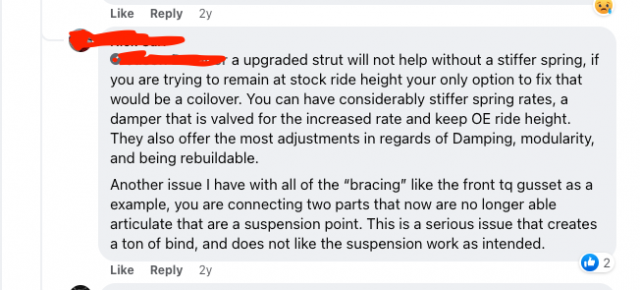Hi All,
I was doing some research on the benefits of getting a front subframe brace and came across this comment on a Fiesta ST Facebook Group (see attached and quoted):
"a upgraded strut will not help without a stiffer spring, if you are trying to remain at stock ride height your only option to fix that would be a coilover. You can have considerably stiffer spring rates, a damper that is valved for the increased rate and keep OE ride height. They also offer the most adjustments in regards of Damping, modularity, and being rebuildable.
Another issue I have with all of the “bracing” like the front tq gusset as an example, you are connecting two parts that now are no longer able articulate that are a suspension point. This is a serious issue that creates a ton of bind, and does not like the suspension work as intended."
I know some have talked about the benefits of reducing deflection by adding a traction bar, but I am concerned about adding one of these.
FYI The person that I quoted has significant amount of track time with this car.
Any of you suspension experts mind chiming in on the validity of the statement in regards to binding and not allowing suspension to work?

I was doing some research on the benefits of getting a front subframe brace and came across this comment on a Fiesta ST Facebook Group (see attached and quoted):
"a upgraded strut will not help without a stiffer spring, if you are trying to remain at stock ride height your only option to fix that would be a coilover. You can have considerably stiffer spring rates, a damper that is valved for the increased rate and keep OE ride height. They also offer the most adjustments in regards of Damping, modularity, and being rebuildable.
Another issue I have with all of the “bracing” like the front tq gusset as an example, you are connecting two parts that now are no longer able articulate that are a suspension point. This is a serious issue that creates a ton of bind, and does not like the suspension work as intended."
I know some have talked about the benefits of reducing deflection by adding a traction bar, but I am concerned about adding one of these.
FYI The person that I quoted has significant amount of track time with this car.
Any of you suspension experts mind chiming in on the validity of the statement in regards to binding and not allowing suspension to work?

